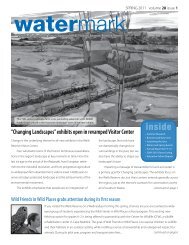Management Plan - National Estuarine Research Reserve System
Management Plan - National Estuarine Research Reserve System
Management Plan - National Estuarine Research Reserve System
Create successful ePaper yourself
Turn your PDF publications into a flip-book with our unique Google optimized e-Paper software.
<strong>System</strong>-wide Monitoring ProgramThe NERR <strong>System</strong>-wide Monitoring Program(SWMP) provides standardized data on nationalestuarine environmental trends while allowing theflexibility to assess coastal management issues ofregional or local concern. The principal mission ofthe SWMP is to develop quantitative measurementsof short-term variability and long-term changein the integrity and biodiversity of representativeestuarine ecosystems and coastal watersheds for thepurpose of contributing to effective coastal zonemanagement. The program is designed to enhancethe value and vision of the <strong>Reserve</strong>s as a system ofnational reference sites. The program currently hasthree main components.Abiotic VariablesThe abiotic factors collected by the NERRS-SWMPinclude temperature, specific conductivity, pH, turbidity,dissolved oxygen (both % and mg/l), waterlevel, chlorophyll-a, orthophosphates, combinednitrate/nitrite, silicates, and ammonia for waterquality monitoring; and air temperature, relativehumidity, wind speed and direction, barometricpressure, precipitation, and PAR (photosyntheticallyactive radiation) for meteorological monitoring.Each <strong>Reserve</strong> uses a set of YSI automated waterquality instruments and a Campbell Scientificweather station to collect data. The data undergoquality control and are then submitted to a centralizeddata management office.Biological MonitoringThis vegetation monitoring program will utilizea Tier I approach and aerial photography to mapthe distribution of the common salt marsh grassesPhragmites australis (usually adjacent to uplandborder including road beds, dredge spoils, etc.),Spartina patens (a dominant species in the highmarsh) and Spartina alterniflora (a dominant speciesin the low marsh). The second task will employTier II methods to assess the relationship betweenupland land use, elevation and the abundance ofcommon marsh plants.Figure X.2. A researcher records the location of anexperiment lead by Dr. Mark Bertness of BrownUniversity which investigates the effect of globalwarming on salt marsh vegetation.Land Use and Habitat ChangeThis component of SWMP will be developed andimplemented for purposes of identifying changes incoastal ecological condition with the goal of trackingand evaluating the status of estuarine habitatchange and watershed land use for all the reserves.The main objective of this element will be to examinethe link between watershed land use activitiesand coastal habitat quality. The basic questionto be addressed is: “What is the magnitude andextent of habitat change in estuarine systems andhow are these changes linked to watershed landuse practices?” The use of the NERRS HabitatClassification Scheme will support monitoring ofland use and habitat change.Data collected by the NERRS-SWMP are compiledelectronically at the centralized data managementoffice (CDMO) at the Belle W. BaruchInstitute for Marine Biology and Coastal <strong>Research</strong>of the University of South Carolina. CDMOprovides additional quality control for data andmetadata. NERR-SWMP data are formatted tomeet the standards of the Federal Geographical<strong>Management</strong> <strong>Plan</strong>: <strong>Research</strong> and Monitoring81




